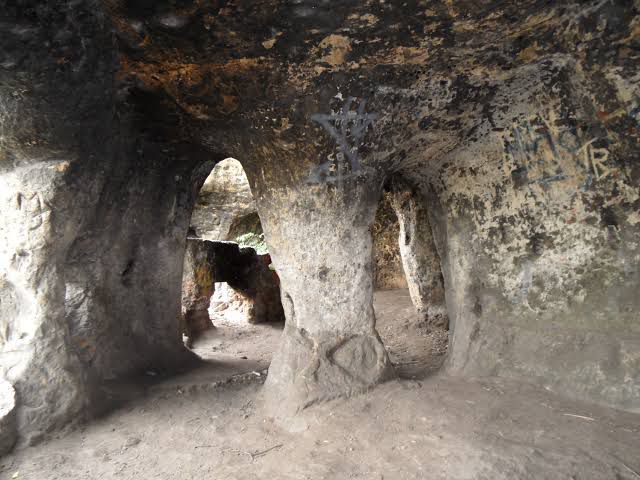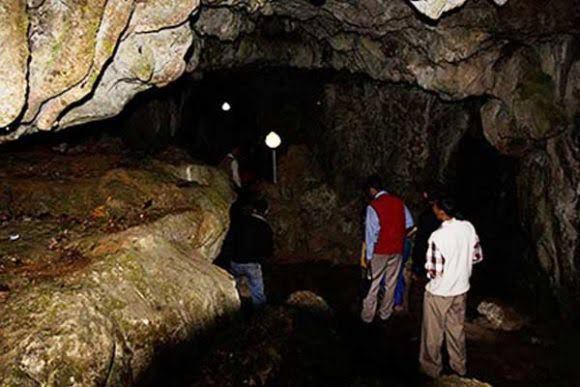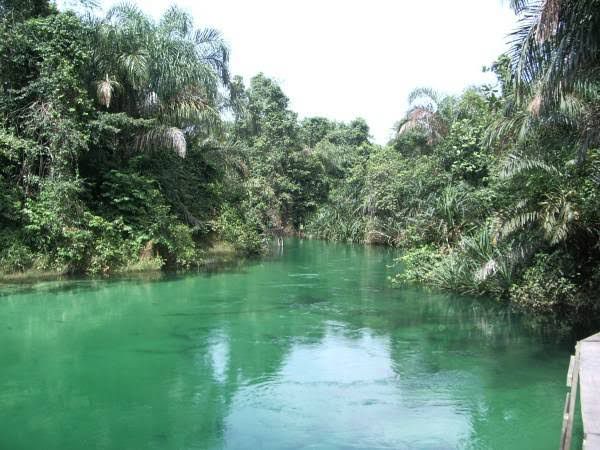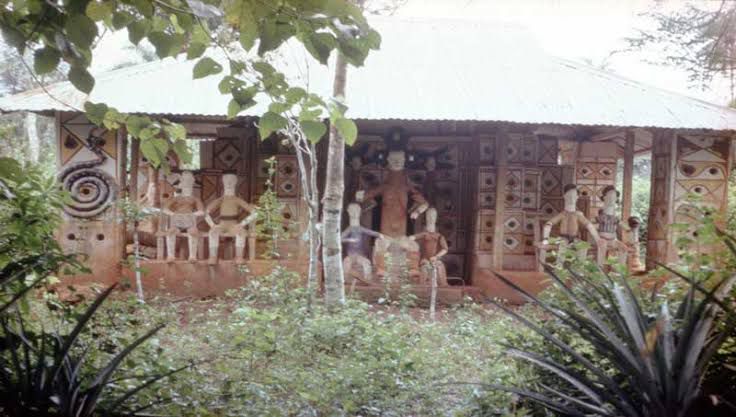By Joy Chinecherem
The world they say is full is of wonders, beautiful and mind-boggling natural landmarks. With the passage of time man has added his imprints too to these landmarks, sometimes beautiful and sometimes destructive.
The South-Eastern part of Nigeria has its own share of these nature’s wonders, beautiful landmarks that intrigues. Here are some of the unpopular historical places:
Ohum Waterfalls And Falls

Ohum waterfall, situated in the valley village of Amaugwe in Awhum town in Udi Local Government Area of Enugu state, a valley town bounded on all sides by ravishing rolling hills covered in supple-looking green grass.
This breathtaking waterfall cave officially known as Awhum waterfalls is about 30 meters in height, birthed as a result of a massive outcrop of granite rock with water cascading over the top, forming a stream. It has several caves lining the track to the waterfall, the track itself is actually a small stream with big rocks overhanging in some places along the track.
The waterfall is famed to have healing powers and also the ability to eliminate evil forces, no doubt it has this mystic aura that cast a unique distinctive beauty on it. One of the wonders of the waterfall is how a section of it stays warm all through the seasons, It is for these reasons the falls have become a place of Christian pilgrimage and a prayer center.
The valley town which also boasts of numerous pristine lakes, some of them with beautiful white sand beaches are located about 24 kilometers from Enugu and it is bounded on the north by Okpatu, in the east by Nike, in the south by Ukana and in the west by Egede communities.
Amanchor Wonder Cave

The Amanchor cave located at Etiti Amanchore, Afikpo South in Ebonyi state is about 3-4m in height. This cave passing through time holds a lot of secrets, it was claimed to have served as a safe house during the Nigerian civil war, where tales abound on how the people survived there. The uniqueness of this cave is that it has several tunnels that lead to various locations that makes it accessible through Abakaliki to Afikpo, Ngusu, and Mile 2 along Akaeze/Ngusu roads (about 140km and 76km from Enugu and Abakaliki respectively). The story of the Afikpo people can’t be told without the Amanchor Cave which stands in their cultural and spiritual lifestyle.
Long Juju Slave Route


The Arochukwu long juju is popular all over Igbo land, originally called Ibini Ukpabi but known among the British as the Long Juju, served as a mediator for the people in different cases.
There is a six-foot gully though now covered in thickset forest that leads into the ancient Cave Temple. This is the main oracle shrine of Ibini Ukpabi and by which stands as if on guard the cult statue of Kamalu “the warrior god”.
The site also contains an altar, which is the kitchen area. A waterfall (the loud sound of which from a distance is regarded as the prophetic voice of Ibini Ukpabi). There is also the throne of judgment – the dark presence (“the Holy of Holies”) those who were found guilty walked into dark tunnels and those found innocent returned to their relatives. Other features include a hill of rags. That is the place where the condemned were required to undress and leave their clothes before they disappeared into the tunnels around the hill of rags. There is also the tunnel of disappearance, which is the dark tunnels into which the victims disappeared.
At the site can be found the red river where it is said that as the victims disappear, the aro would colour the river red to give people the impression that the condemned has died, the red water flowing down the stream would be a sign to the relatives that the victims were dead. Yet another feature is the Iyi-Eke – an outlet from where the victims now blindfolded walk to “Onu Asu Bekee” (the European beach, which later became the government beach) and from there, waiting boats took the enslaved to Calabar for onward transmission to Ala Bekee.
Azumini River

The Blue River, a former slave route in the town of Azumini in Ukwa East Local Government Area of Abia state is one spectacular sight.
The river, which turns green when it rains, begins its course through the community of Okpu-Umuobu, Aba, running along the border with Akwa Ibom.
According to research, the river’s route served as a route for inter-communal trade, for businesses like the oil palm trade between the hinterland communities and the Royal Niger Company, as well as the trade in enslaved people.
In a video by the Ijeoma E. Onuigbo Life Foundation, it suggests that the river was the site of the sale of King Jaja of Opobo as a slave to Bonny Island.
According to Folio NG “Between 1999, 2003, 2007, there was a gazetted documentation by the National Assembly during the time of Adolphus Wabara,” another respondent says. “I think Azumini [inland] port or dry port is also gazetted in the international catalogue.The quality of sand and colourful stones in the river influenced the location of International Glass Industries at nearby Aba. In a preview of Africa Magic Igbo’s Onye Ije The Traveller series, a diver with a bucket is seen preparing to enter the water at a part called Minichu, where it would take him three minutes to fill it with sand. The river has been cited as a research site for the Philippines-based World Fish Center. Reports in Nigeria further credit the river as the discovery site of an extinct primate, the C. Sclateria.
The river has three stretches: Mini Ogigo, Agbatu Samango, and Mini Obuaku, the largest one, with a wholesome view
Mbari Cultural Center

Mbari is a traditional arts and crafts center retained by the Imo State Council for Arts and Culture. Situated at Ikenegbu in Central Owerri, Mbari, it is an open-air museum that houses monumental arts depicting the culture, tradition, and history of the Igbo people. Sometimes referred to as the ‘house of gods’, it is a huge tourist attraction.
Top Five (5) Biggest And Busiest Markets In Igboland
Although Mbari is a monumental art sacrifice to “ALA” the earth goodness, it also shelters artistic representations – artifacts as well as sculptures- which tell of the prevalent social life of the Igbos and images of other prominent deities that inhabit the traditional Igbo cosmic system. These deities include Amadioha (the god of thunder), Ogwugwu (the god of the forest), Nwaorie (the goddess of Nwaorie River), Ahiajoku (the god of harvest), etc. Closely attached to each deity are images of animals such as monkeys, tortoise, rams, snakes, and owls, believed to represent errand spirits or mystical messengers of the deities.
There are also images of Ikoro, the Igbo traditional instrument for communicating messages; unfamiliar creatures such as the ostrich (Enyi Nnunu); a certain tall figure representing Alakuko, allegedly the tallest man in Igboland; ‘Onye afo toro’, a man whose stomach became bloated because he committed an abomination against Ala, etc Contrary to general assumption, Mbari Cultural Center is neither a center for idol worship nor an idol in itself. It is an art form that has its origin very deep in Igbo cultural and religious beliefs and practices. The Mabari cultural center is a three-dimensional cultural facility, made up of the Mbari House, Mbari Museum Kitchen, and an amphitheater, and definitely a must-see location.
Post Disclaimer
The opinions, beliefs and viewpoints expressed by the author and forum participants on this website do not necessarily reflect the opinions, beliefs and viewpoints of Anaedo Online or official policies of the Anaedo Online.

